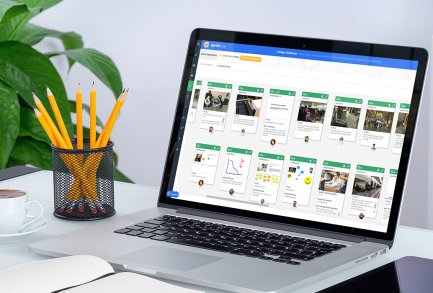11 ways to make a short remote innovation project a success
You can achieve a huge amount in a short period with a virtual design thinking project. While some teams want to come together for several weeks or months to tackle a challenge, others want to run short, sharp projects to find a quick solution.
And with the right preparation, attitude and structure in place, that’s totally possible. To help make sure your short design thinking projects are a success, we’ve shared our top tips:
1. Give teams a rundown of what design thinking is
To help everybody hit the ground running, give your team a clear explanation of what design thinking is to read in advance. This will give them a broad understanding of the structure, mindsets and steps involved, and a common language, too.
If you have time, have a quick video call so that you can answer questions and make sure people are clear about the terminology they’ll be using throughout the project.
These steps don’t need to take long, but without them you could end up wasting time navigating confusions that could have been avoided.
2. Get comfortable with the tight time frame
Any short project is going to be fast-paced with a strict structure. To keep you on track for a solution, the project has to keep moving, regardless of how much more time you’d like to have. Understand that the constraints may feel frustrating, but that they’re there to keep things moving. Have faith, embrace the process and you’ll be amazed by what you can achieve.
3. Be clear about who you’ll involve at each stage
To save time when the project is underway, agree which elements will be best completed by the core team, and which will benefit from wider involvement.
For example, it’s best to have just the core team doing interviews. However, when you’re running a brainstorm, a variety of viewpoints will be useful.
4. Narrow down which empathy building tools you’re going to use before you start
You won’t have time to teach everybody how to use every tool, so just choose one or two.
To make sure you gather truly useful insights in the time available, decide whether you want to, for example, do desktop research, user journey maps, interviews for empathy, observing people in the field, extreme users – whatever works best for your challenge – and make sure everybody understands what they need to do.

5. Agree who you want to interview before you start
You will want to use all of your assigned insight gathering time to speak to people. So before you start your project, make sure you’ve worked out who you want to engage.
Have conversations internally about your personas, your extreme users (if applicable), and who’s going to carry out interviews and when.
Make sure you’re clear about how long you’ll have to complete this section of the project, so that you can arrange in advance who will do what and by when.
6. Accept that your prototypes will be basic
What’s most important when you’re running a short project and working towards a solution, is that you put pen to paper and start drawing up ideas. There won’t be time to make cool or functional prototypes – they’re going to be rough sketches of what your ideas could look like in practice.
So try to get comfortable with the idea of just getting something down, sending it out and iterating based on the feedback you gather.
7. Don’t be scared to fail
Ambiguity is very much part of the deal with any design thinking project. Success comes from being OK with how vulnerable you need to let yourself be throughout and going with it.
Everybody in the team needs to be brave enough to put their ideas out there for all to see. If you don’t, you’ll limit your team’s potential and only come up with familiar solutions. Generating truly innovative ideas that challenge the status quo takes courage.
8. Schedule regular check-ins
The shorter the time frame you’re working to, the more important it is that you check in as a team regularly. Things will be progressing at speed, so you want to make sure everybody always has the most up to date information at every stage. For example, sharing what everybody’s been hearing in their interviews will make it easier to spot common themes and generate accurate insights quickly.
9. Remember this is more than just a side project
Thinking of this as a key project – not just for you but for the organization – will encourage you to use your time effectively, and use the resources available to help make it a success. For example, could somebody in your team help schedule interviews? Or put check-ins in the diary?
10. Make a really good design brief
It makes a huge difference if whoever is running the project takes the time to add some extra context to the challenge you’ve agreed to tackle.
For example, if you’ve said you’re going to explore how you can make the experience of working from home better for people, give more information about what exactly you want to look at. Emerging remote working trends you could take advantage of? How to support working parents who are juggling homeschooling and jobs?
Adding extra detail from the start will help give the team more focus straightaway.
11. Always make a video pitch before you sign off
Only the core team will have a detailed understanding of what happened at each stage of the project. So, to help colleagues and stakeholders who come to your project summary further down the line get up to speed, make a video pitch to walk them through the journey (not just the solution). In a short clip you can tell them about the challenge, who you spoke to, what your ‘how might we’ questions were, the prototypes you came up with, and the solution(s) you settled on.
This is a great way for your team to bring together everything you’ve learnt in a short period, and show others how far you’ve come.
Looking to run a virtual design thinking project to find creative solutions to the problems you’re facing? We can help.
More from the blog

Better Brainstorming
Time and time again, we’re expected to pluck ideas out of thin air. And not just any idea, but innovative sparks of inspiration destined to kick ass and impress the C-suite.

8 cool things you can do on Sprintbase
We love using your feedback to make your journey better, and to help you achieve even more amazing results.

Great icebreakers: How to kick off a virtual workshop
Whatever kind of design thinking workshop you’re running – whether in-person or virtual – it’s so important to take a few moments before you kick off to get your participants warmed up, comfortable with one…
Get a free trial
Contact us to get your free trial or to talk about how Sprintbase can help you achieve your remote innovation goals.
Get started





